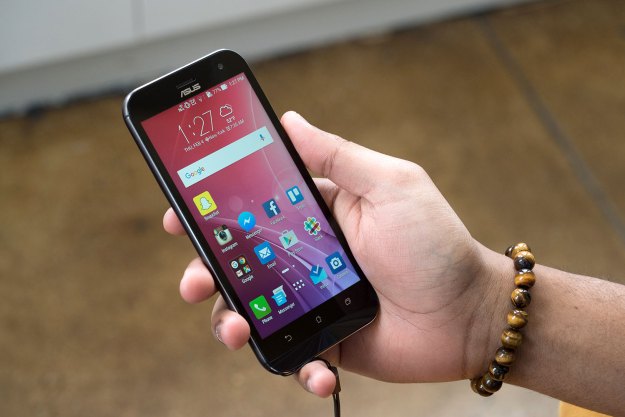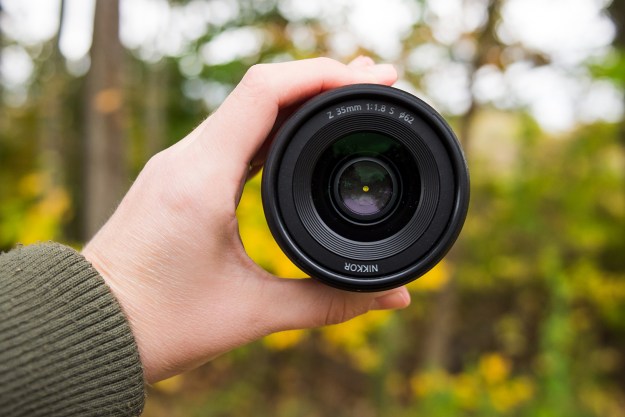
“Asus’ Zenfone Zoom should be a photographer's dream phone, but it takes average pictures.”
- Dedicated camera buttons
- Good battery life
- ZenUI offers some customizability
- Camera offers good details with zoom
- Thick
- Too much bloatware
- Busy user interface
- Camera sensor doesn’t do zoom justice
Chances are you have zoomed in with your smartphone camera to try and get a better shot every now and then, but you probably ended up with a mediocre, poor quality shot.
That’s because you’re not really zooming — your smartphone is zooming in on what’s already in the frame. Digital zoom is rarely a good idea, and it’s completely different from the zoom you would see on a DSLR camera.
Asus tried to tackle the problem with the Zenfone Zoom, which features 3 times optical zoom and optical-image stabilization, but sadly, the Taiwanese company completely missed the mark. Although optical zoom is rare on smartphones, it was the main attraction on Nokia’s Lumia 1020. Even though the Lumia and its Zeiss optics are several years old now, the Zenfone Zoom doesn’t improve much upon Nokia’s aging Lumia 1020.
The Zenfone Zoom isn’t a bad phone — it’s decent, but it’s also far from being worth $400, and it doesn’t deliver on its promise of taking better photos than your average flagship
A slippery start
The Asus Zenfone Zoom is quite the brick. At 5.5-inches, it’s also burdened with sizable bezels that do nothing but make the device look less appealing. You’re sure to feel the Zoom in your pocket, as it’s 11.95mm thick. When you compare that with the
Yet despite its thickness, the front and sides of the phone feel relatively high end, especially with the metal frame and rounded corners. Unfortunately, it loses all feeling of quality when you touch the faux-leather back. The material on the back is also extra slippery, and perhaps that’s why Asus includes a wrist strap on the bottom of the phone.
The buttons on the side of the phone offer good feedback and aren’t hard to press, and the Zoom’s dedicated video record and camera shutter button is quite possibly the best function of the
The capacitive buttons are fine too, though they look dated. The design for the home, back, and recent app buttons look like the ones you would find on phones from Android’s early days. In another old-fashioned move, the headphone jack is located at the top of the phone. However, the back cover is easy to remove, so you can throw in your SIM or a MicroSD card. Sadly, the battery is not removable or replaceable.
Bloat, bloat everywhere
As with most of Asus’ phones, you’ll find yourself booting up a device that has dozens of third-party apps that offer little to no value to you. There are duplicate apps of almost everything from the gallery and mail, to the calendar and
Apps like Clean Master will constantly nag you with notifications.
The Zoom runs on
ZenUI can be a little overwhelming with its need to present more information than necessary, and looks old and outdated. Although you can choose between numerous paid and free themes to update the look of the skin and icons, ZenUI just isn’t as nice to look at as stock
Thankfully, the phone makes up for its lackluster
The main problem with popping all that bloatware and a UI on top of
Zooming with the Zoom
The camera is what’s on everyone’s mind when they see the huge camera hump on the back of the Zoom. There’s a 13-megapixel camera inside that bulge, but it’s the 3x Optical Zoom Hoya lens that takes up most of the room.
Asus made the volume rocker into a dedicated zoom button to make it easier to zoom in on the subject you want to shoot in the camera app. Press the volume down end of the rocker, and you zoom out. Press the volume up end, and you zoom in. The zoom is actually pretty good, though not as impressive as we were hoping it would be, given that huge camera hump on the back of the phone.
The photos themselves have good enough color balance and detail, but thanks to the average sensor, the resulting images look dull when compared to pictures we took with the Samsung Galaxy S7, LG G5, and the
For example, take a look at the two images below. One was shot on the
The zoom itself really struggles with details when you zoom in, but you can get some solid shots as long as you only zoom in up to 3x. Don’t expect anything of great quality to come out for anything higher.
The photos look dull when compared to those captured on the Galaxy S6 or the
It’s easy to tell the difference between a phone, like the G5, that uses a digital zoom versus the Zenfone’s optical zoom. The G5 doesn’t do too bad of a job, but the details are far more crisp when zooming into the same object at 3x.
The Zoom’s camera app, thankfully, is one of the phone’s sleeker elements. It’s dead simple to use, and anyone can quickly pick up how to use it. Switching between manual and auto is a breeze, thanks to a button right next to the shutter icon.
We greatly prefer Asus’ manual controls as opposed to the ones found in LG’s G5. The G5’s spans horizontally through the camera app and can be distracting, whereas the Zoom’s stay on the side near the shutter icons, with easy-to-use sliders to quickly change settings like ISO and the shutter speed.
The camera app’s design is reminiscent of
- 1. iPhone 6 Plus
- 2. Asus Zenfone Zoom (ZX551ML)
You can choose between several modes in the camera app, such as
The camera gallery also has fairly decent editing tools with filters if you didn’t want another app like Snapseed or VSCO Cam. There’s also a beautification tool that lets you make your eyes bigger, remove blemishes on your skin, and more, but these are more gimmicky than actually usable.
I took advantage of the manual mode for a few photos and went on a spree around Barcelona after Mobile World Congress, and ended up with the photos below.
For the most part, the photos came out well, if not pretty good. But there’s a lack of depth to all of them, and some photos look dull. A lot of the time after taking a photo I end up asking where the depth of field is in most of my shots, because it’s surprisingly not there even with an aperture of f/2.7.
It’s the optical zoom that impressed me more, as it actually did come in handy for a few shots.
Overall, I found that a lot of photos I took with my Nexus 5X to be far superior to the Zenfone Zoom’s photos in terms of speed and quality, which shows that the Zoom’s most advertised feature is its only selling point.
Specs and battery life
The 1080p resolution on the 5.5-inch display is hardly anything to write home about, but it gets the job done. Don’t expect great visibility in direct sunlight, even with the brightness slider all the way up.
The Zenfone Zoom features fast charging, a feature found in most mid to flagship devices today. The 3,000mAh battery is more than enough to last you through a long workday, and I often found myself coming home with more than 30 percent remaining.
The Zoom is powered by Intel’s Atom processor with 4GB of RAM instead of the typical Qualcomm Snapdragon chip. The 32GB and 64GB versions come with the Atom Z3580 (our model), and the 128GB edition is packed with the Atom Z3590.
The Z3580 processor was more than enough for us. The Zenfone Zoom didn’t get too hot when playing games or downloading apps, and it rarely bogged down or needed a restart.
The U.S. version of the phone is unlocked, but it doesn’t support CDMA networks – so you’re stuck with having to use this phone on AT&T or T-Mobile. It won’t offer full 4G LTE connectivity though, as it doesn’t support the complete range of frequencies.
Warranty information
Asus offers a one year parts and labor warranty from the date of purchase. As long as defects stem from the manufacturing or the software side of the phone, without any tampering, you’ll be covered for a year.
Conclusion
Asus’ Zenfone Zoom has a pretty decent camera at a price tag of $400. But you’re buying the phone, not just the camera bump.
For the price, the Zenfone Zoom certainly gets the job done without any stutters and hiccups. Its performance is comparable to the Moto G (2015), the Nexus 5X, and many other leading smartphones in its tier. We just can’t recommend it because it sorely lacks any style in its user interface and design; not to mention, the camera just isn’t good enough.
Using TouchWiz on an older Samsung device like the Galaxy S5 feels leagues better than using ZenUI on the Zoom – and that’s due to a combination of a chunky and slippery phone with bloatware-laden software. Did I mention how annoying Clean Master is?
But Asus does seem to be on top of its monthly security updates (for the most part), and it has done a decent job with the optical zoom on the camera – but seeing as the camera is its primary selling point, it still doesn’t seem worth going the Asus route as opposed to other devices.
The optical zoom certainly performed fairly well and offered some impressive photos, but it never captivated me enough to continue using the phone. Phones with good cameras like the G5 are more than enough to satisfy camera buffs – and you don’t have to deal with a thick bump.
That’s not to say that phones with zoom capabilities aren’t worth it – the Zoom simply doesn’t offer the most optimal results for the money. If you’re really looking into getting something with optical zoom, we’d recommend getting an old-school point-and-shoot camera. When it comes to paying $400 for a
Editors' Recommendations
- How to change your Zoom background on Mac and Windows
- Sony’s new Xperia 1 IV comes with a crazy moving zoom lens
- Oppo details supersmooth optical zoom and new camera sensor for future phones
- Zoom to lift its 40-minute meeting limit for holiday celebrations
- Asus ROG Phone 3 vs. Nubia Red Magic 5G: Battle of the top gaming phones




















